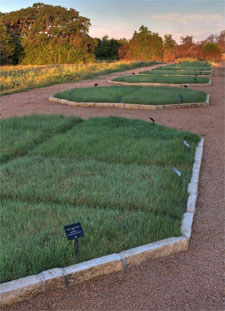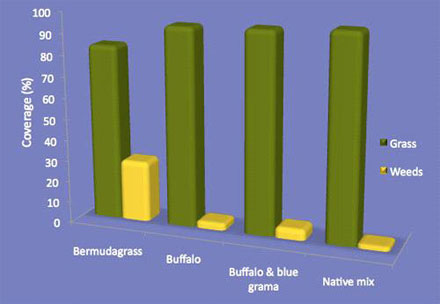Wild About Texas – May, 2010
Native Polycultural Turf Grass

The native turf grass test plots at Lady Bird Johnson Wildflower Center. Photo courtesy of Andrea DeLong-Amaya.
Being a diehard gardener and plant junkie, I tend to discourage new lawns. Lawns are boring! Wait, did I just say that? I mean, how many people can honestly say they “love” their lawns? I’m sure there are a few, and for you folks, there is some new, cutting-edge research that can make your lives easier.
Buffalograss (Bouteloua dactyloides aka Buchloe dactyloides) is a turf grass that is often recommended as a very water-thrifty native alternative to St. Augustine and other non-native turf grasses. But there is a problem: it is all too susceptible to weeds. Buffalograss is a prairie plant adapted to cohabitating with wildflowers and other grasses and does not form a dense weave. In a lawn context, its weakness has been that its lack of tightness leaves open spaces for unwanted plants to get established.
Lady Bird Johnson Wildflower Center scientists, through the auspices of a grant from Wal-Mart, have developed a solution to the problem by acknowledging this growth characteristic of buffalograss and working with it. They have identified a handful of other native grasses that have similar height and leaf texture, such as blue grama (Bouteloua gracilis) and curly mesquite (Hilaria belangeri), to keep the “polycultural” (multiple species as opposed to a monoculture) blend looking uniform. The variety of species keeps the turf as a whole more robust and stable. Gaps in the growth of one species will be filled in by another species. Weather patterns change from one year to the next, favoring one species over another. So, in any given year, if one species is hampered, the others will “fill in,” so-to-speak. Visitors to the Lady Bird Johnson Wildflower Center can view the native turf grass research plots, accessible from the Restoration Research Trail.

This chart shows that a mixture of native grasses can have more than twice the leaf density of bermudagrass.

This chart shows that native grasses are better at keeping out weeds than bermudagrass.
Unlike bermudagrass, native turf is not invasive. The blends are drought-resistant and resilient when faced with diseases and insect problems, and they require less fertilizing than standard selections. They grow more slowly and peak at a shorter height (around 8 inches or less), reducing the constant need to mow. This saves time as well as fossil fuels.
Now is a good time to start these warm-season grasses from seed. For those interested in trying a lawn of native grasses, Native American Seed and Douglass W. King companies both vend Texas native turf blends in seed by the pound. See their websites for more information.
For more information about Texas native plants, visit the Wildflower Center’s website at www.wildflower.org.
About the author: Andrea DeLong-Amaya is the director of horticulture at the Lady Bird Johnson Wildflower Center in Austin.

